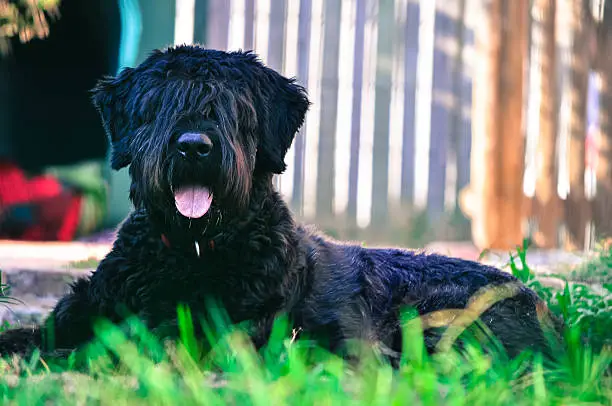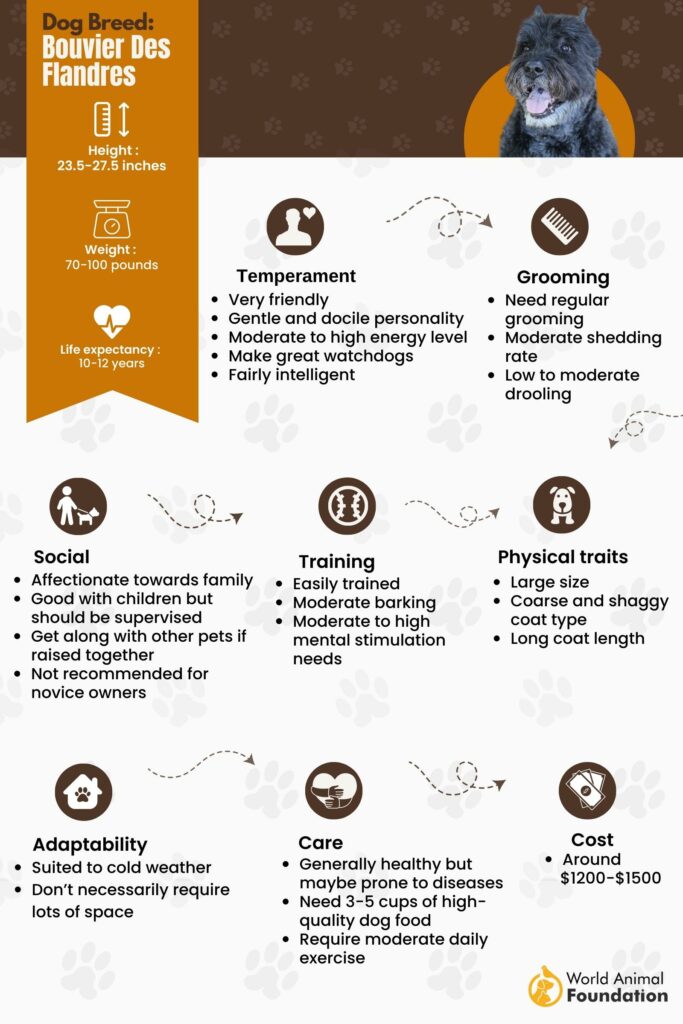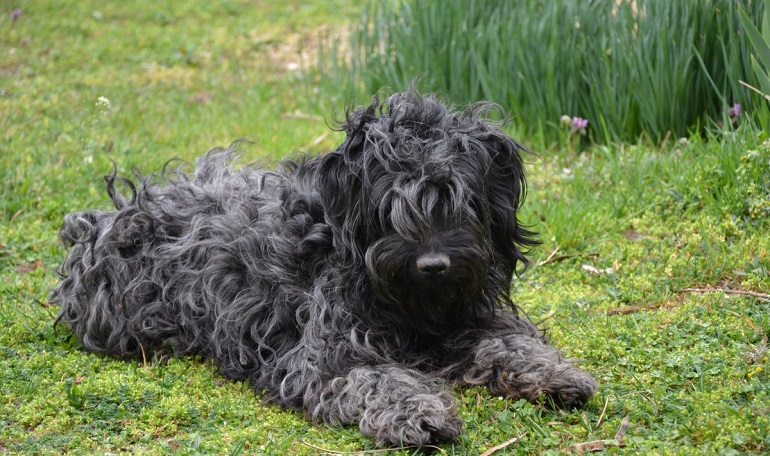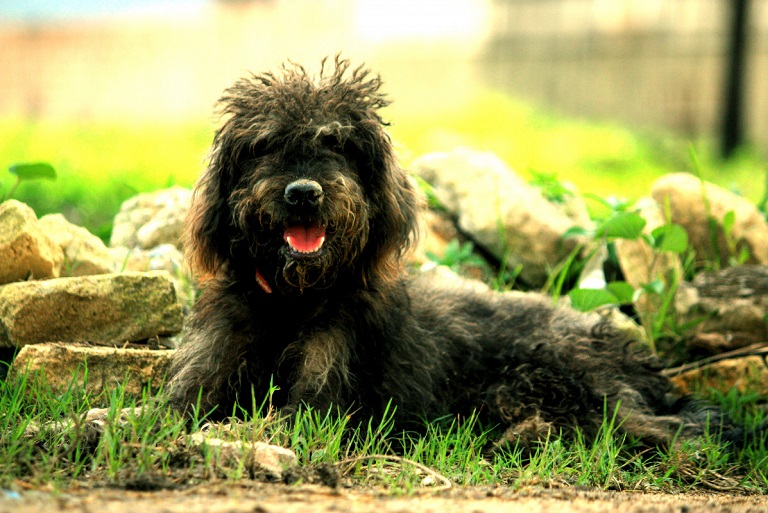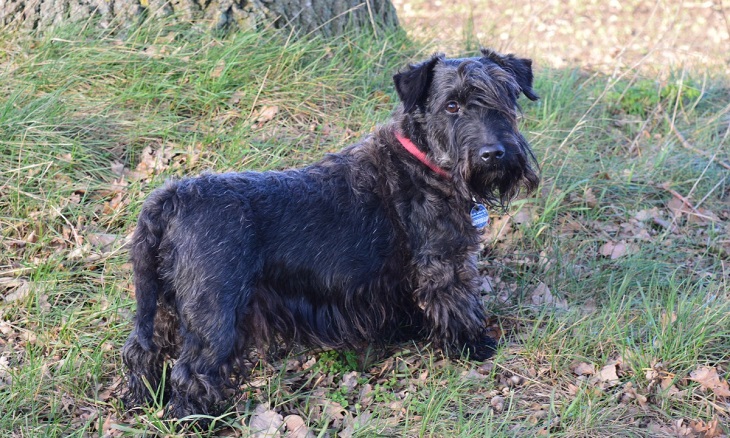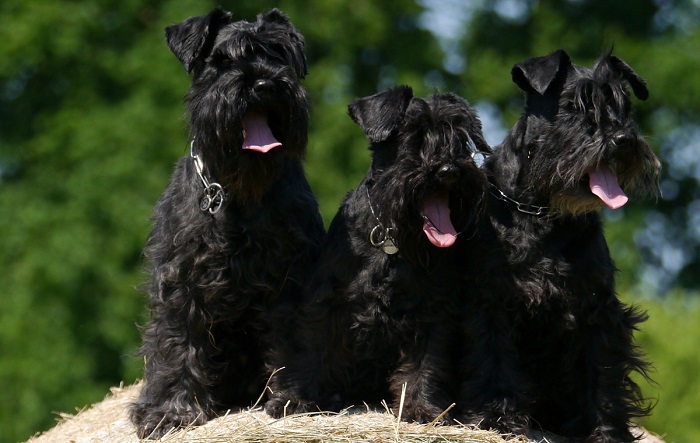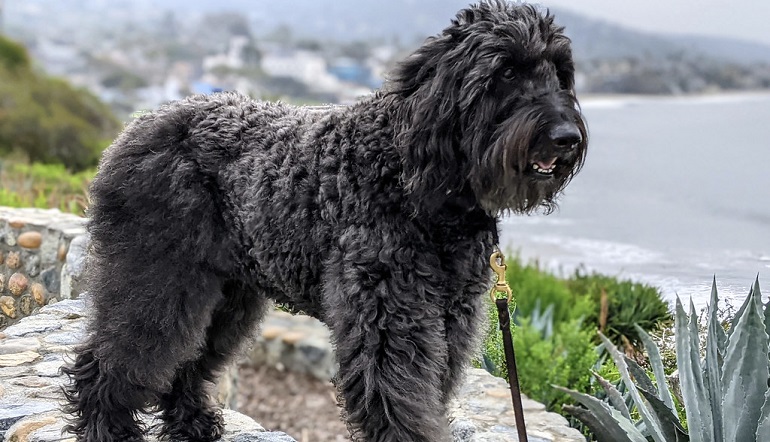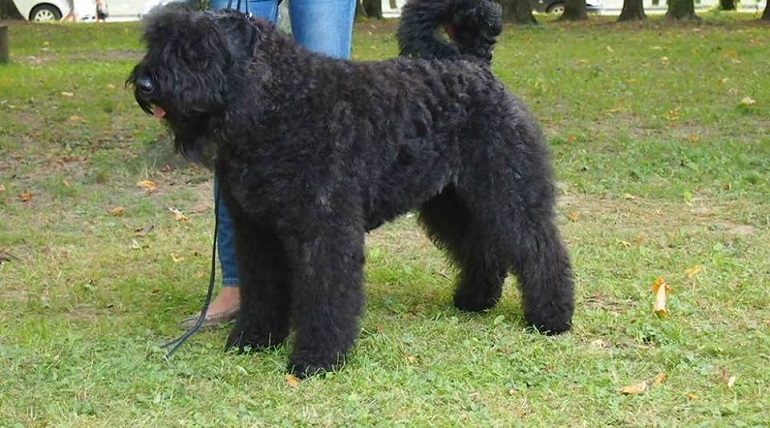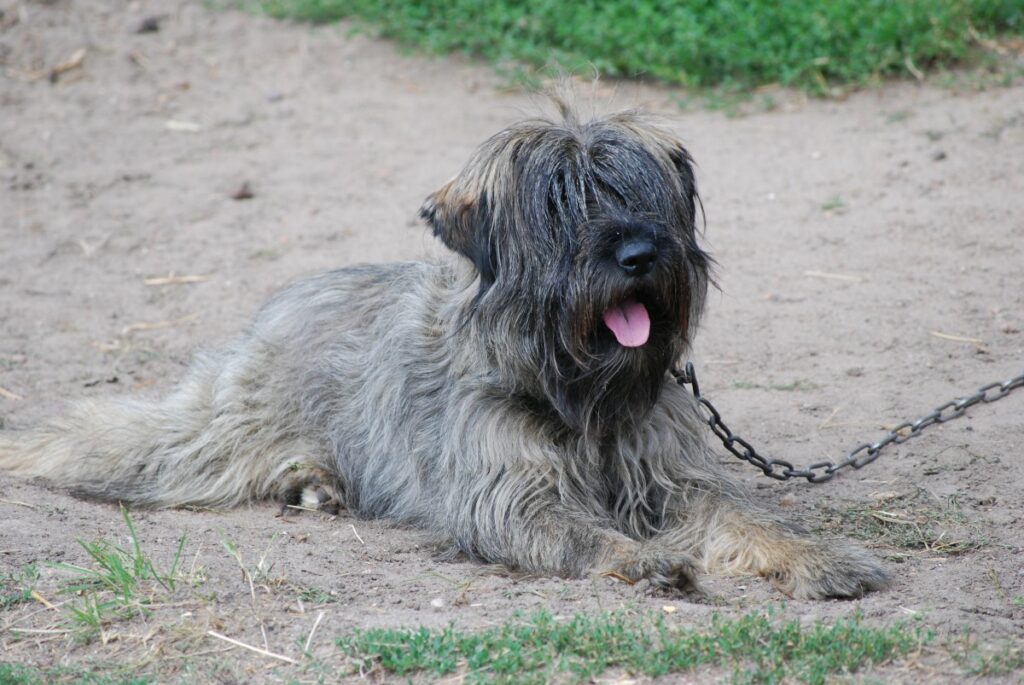The Bouvier des Flandres, a powerful and rugged herding dog, boasts a rich history intertwined with the Flemish countryside. Bred for demanding farm work, these intelligent and devoted companions possess a unique shaggy coat requiring specific grooming techniques. From their origins driving cattle and pulling carts to their modern roles as loyal family members and skilled working dogs, the Bouvier’s story is one of resilience and adaptability. Discover the fascinating history, intriguing facts, and essential grooming practices that make this breed a truly remarkable canine companion.
The Bouvier des Flandres may look outlandish and unusual with a big frame and a whole lot of hair, but… it’s a sweetheart.
Bouvier means a cow herder or a cattle driver. The Bouvier des Flandres originated in Flanders, Belgium, as a herding dog to herd cattle and help farmers with daily tasks.
These all-rounders can be trained to perform all sorts of activities and dog sports. Due to its protective nature, it works great as a guard dog.
The Bouvier was bred to be a versatile farm dog, but now it is more commonly used as a guard dog, police dog, and search and rescue dog. They love having a job and are very eager to help their owners with all sorts of tasks.
About the Breed
The Bouvier Des Flandres has a striking appearance. The head and face are especially eminent. Shaggy brows, a long beard, and a mustache accentuate its large head.
The Bouvier Des Flandres looks intimidating but is calm and gentle with a pleasant personality. It makes a great family pet and is very loyal to its owner.
Guarding and herding come naturally to this dog breed. Nobody needs to teach them about protecting their family; it is embedded in Bouvier’s DNA.
The breed is shy, reserved, and suspicious of strangers. These qualities make them excellent watchdogs. They protect themselves, their families, and their property. If they suspect something suspicious, they will alert the house and take action.
The Bouvier Des Flandres is sociable with other dogs when raised together. They are great with children too, but tend to push them around just like herding. Due to this reason, they must be monitored around kids.
They need regular exercise to stay healthy. Their shaggy coat requires lots of cleaning. The beard may get dirty while sniffing through mud, hence the name Vuilbaard which means dirty beard.
History of the Bouvier Des Flandres
Bouvier Des Flandres means cow herder of Flanders. The breed originated in the Flanders part of Europe. The land was later got distributed between Belgium and France. The breed helped farmers of Northern France to herd cattle, protect the land, and overall help with tasks on the farm.
Though the same breed, they are also given other names such as Vlaamse Koehand (Flemish cow dog), Vullbaard (Dirty beard), and Toucheur de Boeuf (Cattle driver). Their tasks also included running churners and grinders at the mill and pull carts etc. They also competed in herding trials.
Although the exact ancestors of this dog breed are unknown, they are believed to have come from Sheepdogs, Dutch Griffons, and Barbet. The first breed standard was decided in 1912. The breed made it to America in 1920 and was recognized by the American kennel club in 1929.
They played a very important role in World War I. The working dog acted as a messenger and also helped in locating mines as search dogs. They almost got killed off on the battlefields. Some got blown in the minefields.
The breed suffered a lot post-World War II. For many years, there were less than 20 total dogs registered in America. Some European breed enthusiasts took the job of reviving the breed and bringing it back.
Bouviers are still not popular among other breeds and have suffered a decline in numbers over the past few decades.
Bouvier Des Flandres Facts
- Bouvier Des Flandres does well in open properties of suburbs or the countryside, but it thrives in apartments and condos as well. You just need to take it out for exercise and regular walks.
- The Bouvier Des Flandres breed almost became non-existent after World War II as they were killed on battlefields as well as by mines.
- They are not suitable for novice or first-time dog owners. They have strong personalities and require consistent training.
- In the countries and states that allow, ear trimming and tail docking are commonly performed on this breed. It requires a lot of aftercare to avoid pain and infection.
- Bouvier Des Flandres puppy requires early obedience training. It is up to the owner to set expectations with this breed in terms of behavior.
- The Bouvier Des Flandres breed has a natural herding instinct. They need leash training to stay focused on walks. They also tend to follow bicycles or motorbikes on road.
Breed Profile
If you are interested in buying or adopting a Bouvier Des Flandres, here are a few points to consider;
- Family Life: Highly affectionate with family members and good with young children.
- Energy Level: Moderate to high
- Social: Reserved and shy with strangers
- Playfulness: Moderate
- Watchdog/Protective nature: Very High
- Trainability: Moderately high
- Mental stimulation requirement: High
- Barking Level: Moderate
- Shedding: Moderate
- Drooling: Low to moderate
- Coat: Medium shaggy and rough double coat
- Grooming Requirements: High
- Color: Black, brindle, grey, grey brindle, and pepper and salt
- Dog Type: Herding group
- Size: Big
Bouvier Des Flandres Appearance
The Bouvier is a large, compact, tousle-coated dog with a rugged appearance. They have a rough and shaggy outer coat, while the inner coat is soft. Their most noticeable feature is their prominent head. The shaggy eyebrows, rough beard, and mustache give it an intimidating look.
Their ears are large and triangular that sit straight at top of the head. They can be natural or trimmed. A lot of aftercare is required to maintain trimmed ears.
Bouviers’ tails are also naturally long and shaggy. They are docked to keep short. Docking isn’t always appreciated but works as long as performed by professionals who know how to do it right.
Size
The Bouviers are large dog breeds. Males stand 24.5 to 27.5 inches tall, whereas females stand 23.5 to 26.5 inches tall at the withers.
Weight
These large dogs weigh anywhere between 70-110 pounds.
Coat
They have a double coat. The outer coat is long, coarse, rough, and shaggy. The inner coat is soft and dense. Their coat is also waterproof.
Color Color
The colors of Bouvier Des Flandres range from Black to brindle, fawn, gray, gray brindle, and pepper and salt.
Bouvier Des Flandres Temperament and Personality
The Bouvier Des Flandres is a gentle and kind dog with a strong personality. The dog loves its owners and shares a strong bond with its family. Due to its herding nature, it is very protective of the household.
The Bouvier does not bark much, but it is alert and suspicious. If there is any strange activity going on, it would be quick to inform the owner by barking and pacing.
Bouvier Des Flandres, just like a family member, loves being involved in family activities. Be it working in the yard or playing with kids. It likes the companionship of owners.
If not given enough attention or left alone for longer periods, the dog may develop unhealthy habits such as excessive barking, chasing, or chewing.
Bouvier Des Flandres puppies must be enrolled in puppy kindergarten classes as soon as possible. This ensures that your pup grows up to be a well-rounded dog.
Bouviers are known to have stiff upper lips. They do well with other dogs that they have grown up with. But they may not be very welcoming toward other animals. Early socialization is necessary to help them get along well with people and other dogs.
Bouvier Des Flandres is a great family pet. They do well with children, but due to their herding instincts, they may bark at them or push them. Kids and dogs should always be monitored when together. Kids and younger children must be taught how to behave gently with pets to avoid accidents.
Bouvier Des Flandres Health and Care
Like most breeds, Bouvier Des Flanders is also prone to certain diseases and requires care on the part of pet owners to keep them healthy.
Bouvier Des Flandres Health problems
The Bouvier des Flandres is a large dog breed, and due to the heavy body frame, it is susceptible to some health conditions. It has a life expectancy of about 10-12 years.
The common problems include Bouvier Des Flandres myopathy, cataracts, ectopic ureters, deafness, epilepsy, glaucoma, hip dysplasia, laryngeal paralysis, hypothyroidism, elbow dysplasia, portosystemic shunt, megaesophagus, and subaortic stenosis. Responsible breeders always screen their stock for these diseases before breeding.
Just like other breeds with deep chests, Bouvier can get gastric dilatation and bloat. Always watch out for common signs to take immediate action.
The National Breed Club recommended health tests include the cardiac exam. hip evaluation, ophthalmologist evaluation, and elbow evaluation.
Here are the details of some diseases:
Subaortic Stenosis
This is a heart problem in which the passage between the left ventricle and the aorta narrows down. The blood supply is affected, which causes fainting in dogs. Vets can fix it by performing minor procedures.
Cataracts
In this condition, an opaque layer appears over the lens of the eye. It gives a cloudy appearance to the dog’s eye. Partial blindness can be expected, but cataracts can be removed through surgery.
Glaucoma
It is the condition of the eye where the pressure on the eyes increases. Common symptoms include pain, swelling, and redness of the eye. The eyes can also be runny. If progressed, it can lead to blindness.
Hip dysplasia
In this condition, the head of the femur bone does not fit right into the socket of the hip joint. It is a developmental disease that can be present at the time of birth or may develop later in older dogs if exercised too much.
Hypothyroidism
Hypothyroidism is a health condition in which the thyroid gland becomes underactive and produces less than optimum levels of thyroid hormone. It results in many health problems, such as epilepsy, lethargy, alopecia, obesity, and some skin problems.
Bloat
It is a deadly disease that is common in other dogs with deep chests. If a dog is given one large meal in a day, or the dog drinks too much water at a time, the stomach might twist (gastric torsion) and result in trapped gas.
Due to the large volume of gas, the blood circulation is compromised, and the dog may become unconscious or die. It is important to take quick action in this case to save the dog’s life.
Grooming
Bouvier Des flandres breed has a thick double coat. The outer coat is thick, coarse, and long, whereas the inner coat is soft, short, and dense. The weatherproof coat might not be a positive trait for this breed.
As with other dogs with excess hair, Bouvier des Flandres also requires quite a bit of attention. Their Dutch name translates to ‘dirty beard.’ The coat needs regular grooming and maintenance to avoid dirt, tangles, and debris stuck inside the hair.
This dog doesn’t suffer from hair loss that much, but grooming must begin in puppyhood to make the dog comfortable with the whole process. Trimming and brushing are a must.
Watch out for ticks, mites, and even dried poop in the fur, as that is a common occurrence. Dog’s toenails must be trimmed regularly. The outer ear should be cleaned with a damp cotton ball. And remember to look out for signs of infection.
Dental diseases are fairly common in purebred dogs, so their teeth must be brushed at least twice a week. It also helps in avoiding tartar buildup and bad breath. Again, regular grooming must be started as early as possible, as this breed does not like being touched or handled. Bouvier becomes moodier as the dog ages.
Food and Diet
Bouviers Des Flandres need 3 to 4 cups of high-quality dog food daily. It is important not to give them a large meal. Meals must be divided into two or three portions to be given throughout the day.
Always make sure you ask for the vet’s advice before starting new foods. Follow veterinarian advice or get a custom meal plan according to the size, weight, and activity level of your dog.
Bouvier grows rapidly between months 4 and 7. Offer balanced meals to avoid joint problems and ensure proper growth. Overfeeding can result in weight gain and obesity, which are detrimental to joint health.
Bouvier Des Flandres Training
The Bouvier Des Flandres is an all-rounder dog. A Bouvier puppy can be trained to perform any sort of task that is needed by you. These dogs do best on farms. They look after the stock and guard well.
Obedience training must be started when the puppies are young. Due to the assertive personality, owners must retain their boss’s position consistently. If they see room for weakness in the owner, they fill it with their big personalities.
This is the reason why the breed is not suitable for inexperienced owners. Their dominant nature makes them aggressive and overprotective if not trained or socialized properly.
Their role expectations must be made clear early on. With proper guidance, they can be trained as guard dogs, service dogs, or police dogs.
Conclusion
No need to be startled by Bouvier’s size; it is a dog with a sweet and calm personality. The Bouvier loves its family.
Originally bred as a herding dog, the dog has helped farmers on farmlands of southwest Flanders and the French northern plain in all sorts of tasks such as guarding, pulling carts, herding cattle, etc. It will be willing to help you out with your chores too!
Bouvier Des Flandres also played a vital role in the world wars. It acted as a service dog to sniff for hidden mines and as a messenger to transfer messages. They still make great guard dogs today.
The behavior of Bouvier Des Flandres with other animals and other pets depends upon their training. Remember to socialize the dog with strangers and other dogs at a young age and remain consistent in providing social exposure.
These hairy beasts require regular grooming to look somewhat tamed. Their bushy coat catches on the farm dirt and debris and needs regular care. If you’re too conscious about cleanliness, a Bouvier may not make you very happy.
They need moderate daily exercise and lots of engagement activities. Bouvier is known for their intelligence and does not like being alone or idle. You need to provide Mental stimulation to keep negative habits away.
If you’re planning to adopt the great Bouvier Des Flandres, you’re in for lots of attention, constant companionship, and a helping hand for your tasks. You don’t need to worry about the family’s safety with this one. The dog will guard you with its life!
Related Guide:
- Parti Schnauzer Dog Breed
- Alpine Dachsbracke Dog Breed
- Irish Setters Dog Breed
- Icelandic Sheepdog Dog Breed
The Bouvier des Flandres, a robust and intelligent breed, boasts a rich history intertwined with Belgian agriculture. From herding cattle to pulling carts, their versatility cemented their value. Today, they excel as loyal companions and working dogs, thriving in active homes with dedicated owners. Understanding their history informs their grooming needs; their double coat requires regular brushing to prevent matting and maintain its weather-resistant qualities. With proper care and training, the Bouvier des Flandres offers unwavering devotion and a unique, charming character.

